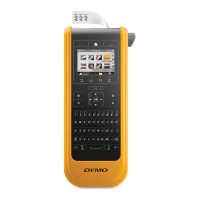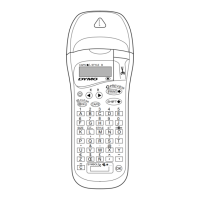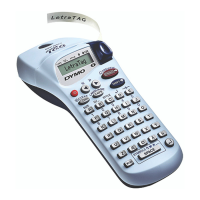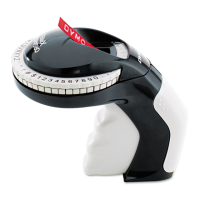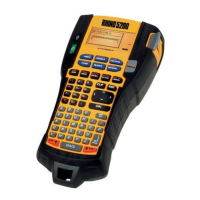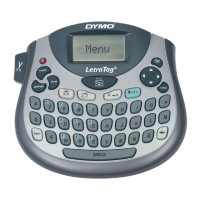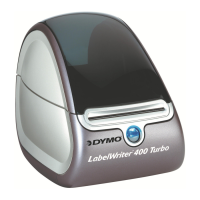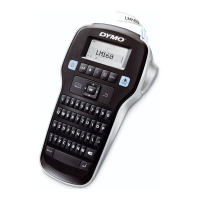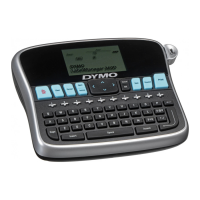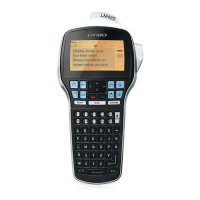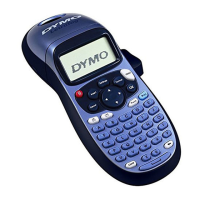Do you have a question about the Dymo XTL 500 and is the answer not in the manual?
Process for registering the label maker online to receive benefits like software upgrades and special offers.
Instructions for fully charging the label maker's rechargeable lithium-polymer battery before first use.
Description of the alphanumeric and function keys on the label maker's keypad.
Overview of the label maker's touch screen display and its main areas.
Description of the label maker's Home screen, which contains all label editor applications.
Explanation of the label editor's features and available function buttons for label creation.
Guidance on viewing labels and finding/fixing errors within label files.
How to input and edit text within a text box on the label.
Steps to adjust the font size of text or use auto-fit to size it to the label.
How to apply bold, italic, underline, or box styles to text on the label.
Steps to rotate text on the label in 90-degree increments.
How to align text horizontally and vertically within a text box on the label.
Steps to insert punctuation characters onto a label using the symbols tool.
How to insert international characters and their variations using alphanumeric keys.
Guide on creating a vertical label with text in horizontal or vertical orientation.
Steps to add additional text boxes to labels, depending on label type.
How to add standard or transferred images to labels.
Instructions for adding and manipulating shapes on a label for custom designs.
Overview of selecting, resizing, moving, copying, aligning, arranging, and deleting objects.
Instructions for moving objects on a label using touch or navigation keys.
How to position objects relative to the edge of the label.
Steps to align multiple selected objects vertically and horizontally on a label.
Procedure for copying and pasting objects within the same label.
How to delete objects from a label, noting that not all objects can be deleted.
Steps to save created labels to the label maker's memory for later use or as templates.
How to open previously saved label files from the label maker's library.
Procedure for freeing up memory space by deleting unneeded saved labels.
Instructions for changing the display language on the label maker.
How to switch between millimeters and inches for measurements.
Steps to adjust the screen brightness for better visibility in different lighting conditions.
How to set the range of labels to print (all, current, or specific range).
Setting the quantity of identical labels to print, up to 99 copies.
Option to control whether multiple copies of labels are printed collated or sequentially.
Configuring how labels are cut during printing (each label vs. all at once).
Instructions for feeding label material manually.
Steps to download and install the necessary DYMO ID software before connecting the label maker.
Procedure for physically connecting the label maker to a computer via USB.
Instructions for cleaning the exterior, keypad, display, and interior of the label maker.
Procedure for cleaning the print head using the provided cleaning tool for crisp labels.
How to clean the internal sensors using the sponge pad of the cleaning tool.
Solutions for issues related to poor print quality, including battery, print head, and cartridge checks.
Indicates that the label supply is low and requires replacement of the label cartridge.
Notification that the label cartridge is empty and needs replacement to continue printing.
Troubleshooting steps for issues with the cutter blade's performance.
Solutions for the label maker not recognizing the inserted label cartridge.
Error indicating incompatibility between the label application and the inserted cartridge.
Indicates the cutter mechanism is missing or not properly inserted.
Solutions for issues where labels are not feeding properly in the label maker.
Instructions for what to do if the label maker overheats.
Error message for unreadable files, suggesting deletion and re-transfer.
Information on ISO symbols and their reproduction rights.
Display of warning symbols used for safety and hazard identification.
Display of prohibition symbols indicating actions that are not allowed.
Symbols related to fire safety and emergency exit signage.
Globally Harmonized System (GHS) hazard pictograms.
Display of various electrical symbols used in diagrams and schematics.
Symbols related to professional audio-visual equipment and applications.
Various common symbols including fractions, punctuation, and currency.
Safety warnings and precautions to reduce risks of fire and explosion during battery charging.
Process for registering the label maker online to receive benefits like software upgrades and special offers.
Instructions for fully charging the label maker's rechargeable lithium-polymer battery before first use.
Description of the alphanumeric and function keys on the label maker's keypad.
Overview of the label maker's touch screen display and its main areas.
Description of the label maker's Home screen, which contains all label editor applications.
Explanation of the label editor's features and available function buttons for label creation.
Guidance on viewing labels and finding/fixing errors within label files.
How to input and edit text within a text box on the label.
Steps to adjust the font size of text or use auto-fit to size it to the label.
How to apply bold, italic, underline, or box styles to text on the label.
Steps to rotate text on the label in 90-degree increments.
How to align text horizontally and vertically within a text box on the label.
Steps to insert punctuation characters onto a label using the symbols tool.
How to insert international characters and their variations using alphanumeric keys.
Guide on creating a vertical label with text in horizontal or vertical orientation.
Steps to add additional text boxes to labels, depending on label type.
How to add standard or transferred images to labels.
Instructions for adding and manipulating shapes on a label for custom designs.
Overview of selecting, resizing, moving, copying, aligning, arranging, and deleting objects.
Instructions for moving objects on a label using touch or navigation keys.
How to position objects relative to the edge of the label.
Steps to align multiple selected objects vertically and horizontally on a label.
Procedure for copying and pasting objects within the same label.
How to delete objects from a label, noting that not all objects can be deleted.
Steps to save created labels to the label maker's memory for later use or as templates.
How to open previously saved label files from the label maker's library.
Procedure for freeing up memory space by deleting unneeded saved labels.
Instructions for changing the display language on the label maker.
How to switch between millimeters and inches for measurements.
Steps to adjust the screen brightness for better visibility in different lighting conditions.
How to set the range of labels to print (all, current, or specific range).
Setting the quantity of identical labels to print, up to 99 copies.
Option to control whether multiple copies of labels are printed collated or sequentially.
Configuring how labels are cut during printing (each label vs. all at once).
Instructions for feeding label material manually.
Steps to download and install the necessary DYMO ID software before connecting the label maker.
Procedure for physically connecting the label maker to a computer via USB.
Instructions for cleaning the exterior, keypad, display, and interior of the label maker.
Procedure for cleaning the print head using the provided cleaning tool for crisp labels.
How to clean the internal sensors using the sponge pad of the cleaning tool.
Solutions for issues related to poor print quality, including battery, print head, and cartridge checks.
Indicates that the label supply is low and requires replacement of the label cartridge.
Notification that the label cartridge is empty and needs replacement to continue printing.
Troubleshooting steps for issues with the cutter blade's performance.
Solutions for the label maker not recognizing the inserted label cartridge.
Error indicating incompatibility between the label application and the inserted cartridge.
Indicates the cutter mechanism is missing or not properly inserted.
Solutions for issues where labels are not feeding properly in the label maker.
Instructions for what to do if the label maker overheats.
Error message for unreadable files, suggesting deletion and re-transfer.
Information on ISO symbols and their reproduction rights.
Display of warning symbols used for safety and hazard identification.
Display of prohibition symbols indicating actions that are not allowed.
Symbols related to fire safety and emergency exit signage.
Globally Harmonized System (GHS) hazard pictograms.
Display of various electrical symbols used in diagrams and schematics.
Symbols related to professional audio-visual equipment and applications.
Various common symbols including fractions, punctuation, and currency.
Safety warnings and precautions to reduce risks of fire and explosion during battery charging.
| Color | Yes |
|---|---|
| Print technology | Thermal transfer |
| Vertical printing | No |
| Maximum resolution | 300 x 300 DPI |
| Maximum print height | - mm |
| Maximum printing width | 54 mm |
| Battery voltage | 14.8 V |
| Display | TFT |
| Control type | Touch |
| Product color | Black, Yellow |
| Keyboard layout | QWERTY |
| Display diagonal | 4.3 \ |
| Housing material | Plastic, Rubber |
| USB 2.0 ports quantity | 1 |
| Connectivity technology | Wired |
| Tape cutting | Automatic |
| Internal memory | 41 MB |
| Built-in barcodes | CODABAR (NW-7), Code 128 (A/B/C), Code 39, EAN13, EAN8, PDF417, QR Code, UPC-A |
| Number of printing lines (max) | 24 |
| Package depth | 408 mm |
| Package width | 144 mm |
| Package height | 364 mm |
| Package weight | 4145 g |
| Cables included | USB |
| Bundled software | DYMO ID |
| Cartridges quantity | 2 pc(s) |
| Maximum label length | 7 m |
| Windows operating systems supported | Windows 10 Education, Windows 10 Education x64, Windows 10 Enterprise, Windows 10 Enterprise x64, Windows 10 Home, Windows 10 Home x64, Windows 10 Pro, Windows 10 Pro x64, Windows 7 Enterprise, Windows 7 Enterprise x64, Windows 7 Home Basic, Windows 7 Home Basic x64, Windows 7 Home Premium, Windows 7 Home Premium x64, Windows 7 Professional, Windows 7 Professional x64, Windows 7 Starter, Windows 7 Starter x64, Windows 7 Ultimate, Windows 7 Ultimate x64, Windows 8, Windows 8 Enterprise, Windows 8 Enterprise x64, Windows 8 Pro, Windows 8 Pro x64, Windows 8 x64, Windows 8.1, Windows 8.1 Enterprise, Windows 8.1 Enterprise x64, Windows 8.1 Pro, Windows 8.1 Pro x64, Windows 8.1 x64 |
| Pallet width | 800 mm |
| Pallet height | 950 mm |
| Pallet length | 1200 mm |
| Pallet volume | 912 dm³ |
| Pallet weight | 157084 g |
| Master (outer) case width | 320 mm |
| Master (outer) case height | 400 mm |
| Master (outer) case length | 440 mm |
| Master (outer) case weight | 9191 g |
| Number of cartons per pallet | 12 pc(s) |
| Number of cartons per pallet layer | 6 pc(s) |
| PC connection | USB 2.0 |
| Country of origin | China |
